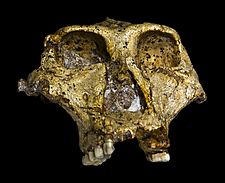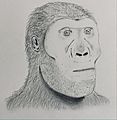Paranthropus robustus facts for kids
Quick facts for kids Paranthropus robustusTemporal range: Pliocene-Pleistocene
|
|
|---|---|
 |
|
| Original Skull of Paranthropus robustus at the Transvaal Museum | |
| Scientific classification | |
| Kingdom: | |
| Phylum: | |
| Class: | |
| Order: | |
| Family: | |
| Subfamily: | |
| Genus: | |
| Species: |
P. robustus
|
| Binomial name | |
| †Paranthropus robustus Broom, 1938
|
|
Paranthropus robustus was an ancient human relative that lived in Southern Africa a very long time ago. This species was first discovered in 1938. Scientists believe P. robustus had special features in its skull, especially its teeth and jaws, which helped it chew very tough foods. Because of these unique traits, the famous anthropologist Robert Broom created a new group, or genus, called Paranthropus, and placed this species within it.
Contents
Discovering Paranthropus robustus
The first discovery of Paranthropus robustus happened in 1938. It was found by a young schoolboy named Gert Terblanche. He found a skull fragment and a tooth at a site called Kromdraai in South Africa. He showed them to Dr. Robert Broom, a paleontologist who was very interested in early human ancestors.
Dr. Broom's Important Find
Dr. Broom quickly realized these fossils were from a new type of hominin. Hominins are the group that includes humans and our closest extinct relatives. He noticed that the skull and teeth were much larger and stronger than those of other early human relatives known at the time, like Australopithecus africanus. This led him to name the new species Paranthropus robustus, meaning "robust" or "strong" human-like creature.
Where They Lived
Fossils of P. robustus have mainly been found in South Africa. Important sites include Kromdraai, Swartkrans, and Drimolen. These sites are part of the "Cradle of Humankind," a UNESCO World Heritage Site famous for its many hominin fossils.
What Paranthropus robustus Looked Like
Paranthropus robustus had a unique appearance, especially its head. They were somewhat similar to other australopithecines, but with some key differences.
Strong Jaws and Teeth
One of the most noticeable features of P. robustus was its very large teeth and powerful jaws. They had huge molars (back teeth) and thick enamel, which is the hard outer layer of teeth. This suggests they ate a diet of tough, fibrous plants.
A Sagittal Crest
Many P. robustus skulls also had a bony ridge on top of their heads called a sagittal crest. This crest was an attachment point for large chewing muscles, similar to what you might see on a gorilla. This feature further supports the idea that they had a "heavy-chewing complex."
Body Size and Shape
While their heads were robust, their bodies were not as large as modern humans. Males were generally taller and heavier than females. Scientists estimate that males weighed around 40-50 kg (88-110 lbs) and stood about 1.3 meters (4.3 feet) tall. Females were smaller, weighing about 30-40 kg (66-88 lbs) and standing around 1.1 meters (3.6 feet) tall.
What Paranthropus robustus Ate
The strong jaws and large teeth of Paranthropus robustus tell us a lot about their diet. They were likely specialized eaters.
A Diet of Tough Plants
Scientists believe P. robustus mainly ate tough, hard-to-chew plant foods. This could have included roots, tubers, nuts, and seeds. Their powerful chewing muscles and thick tooth enamel were perfect for grinding down these kinds of foods.
Evidence from Teeth
Studies of their tooth wear patterns and chemical analysis of their teeth show that while they could eat a variety of foods, their main diet consisted of these hard plant materials. This specialized diet might have helped them survive in environments where other foods were scarce.
When Paranthropus robustus Lived
Paranthropus robustus lived during the Pliocene and Pleistocene epochs. This was a time when many different types of early human relatives walked the Earth.
Timeline of Existence
This species lived from about 2.0 million years ago to about 1.2 million years ago. This means they lived for nearly a million years! During this time, the climate in South Africa changed, which might have affected their food sources.
Coexisting with Other Hominins
Interestingly, Paranthropus robustus lived at the same time as early species of our own genus, Homo, such as Homo habilis and Homo erectus. This means different types of human ancestors shared the same landscapes. They might have competed for resources or lived in different parts of the environment.
How Paranthropus robustus Lived
While we don't know everything about their daily lives, fossil evidence gives us clues about their behavior and social structures.
Living in Groups
Like many primates, it's likely that P. robustus lived in social groups. This would have helped them find food, protect themselves from predators, and raise their young. Some scientists suggest they might have lived in multi-male groups, similar to Hamadryas baboons today.
Using Tools
Evidence suggests that Paranthropus robustus might have used simple tools. Some bone tools found at fossil sites have been linked to P. robustus. These tools might have been used to dig for roots or termites, adding to their diet.
The End of Paranthropus robustus
Around 1.2 million years ago, Paranthropus robustus disappeared. The exact reasons for their extinction are not fully known, but environmental changes likely played a role.
Climate Change and Diet
As the climate changed, perhaps becoming drier or colder, their specialized diet of tough plants might have become harder to find. Species that are very specialized in their diet can struggle when their preferred foods become scarce.
Competition with Homo
It's also possible that competition with early Homo species played a part. Homo species were more adaptable, with a broader diet and more advanced tool-making skills. This adaptability might have given them an advantage over P. robustus in a changing world.
Images for kids
-
Cast of the face of TM 1517, the holotype specimen of P. robustus
-
OH 5 (reconstructed skull above) was made the holotype specimen of the 2nd Paranthropus species P. boisei.
-
P. robustus could have lived in multi-male groups like Hamadryas baboons (above troop at Dierenpark Emmen).
See also
 In Spanish: Paranthropus robustus para niños
In Spanish: Paranthropus robustus para niños










